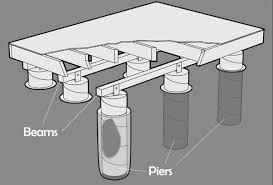Installing a perimeter block pier and beam foundation offers several benefits, making it a popular choice for certain construction projects. This type of foundation consists of piers or concrete blocks placed around the perimeter of the structure, supporting a system of beams that distribute the weight of the building. Here are some of the key benefits of installing a perimeter block pier and beam foundation:
Versatility and Adaptability:
Perimeter block pier and beam foundations are highly versatile and adaptable to various soil conditions and terrain. They can be constructed on uneven or sloping sites where a traditional concrete slab foundation may be challenging or expensive to install. This flexibility allows for more options in selecting suitable building locations.
Enhanced Stability:
The foundation’s design, which includes multiple piers or concrete blocks supporting beams, offers improved stability compared to other foundation types. The piers provide individual points of support, distributing the building load more evenly and reducing the risk of differential settlement. This stability can help minimize foundation movement and potential structural damage.
Accessibility and Utilities:
The elevated nature of the foundation allows for easy access to plumbing, electrical, and HVAC systems. These utility lines can be installed below the floor level, making maintenance, repairs, and upgrades more accessible and convenient. It also provides better protection against potential water damage from flooding or plumbing leaks.
Thermal Efficiency:
Perimeter block pier and beam foundations offer superior thermal efficiency compared to concrete slab foundations. The open space between the ground and the floor provides insulation opportunities, allowing for the installation of insulation materials to enhance energy efficiency. This can result in reduced heating and cooling costs and a more comfortable living environment.
Moisture Control:
The elevated design of a pier and beam foundation provides a barrier against ground moisture. By keeping the structure above the ground level, it minimizes the risk of moisture infiltration, condensation, and associated issues such as mold growth. Additionally, the crawlspace created beneath the structure allows for proper ventilation and moisture control, reducing the potential for humidity-related problems.
Structural Resilience:
In regions prone to seismic activity or expansive soils, a pier and beam foundation can offer increased resilience. The individual piers or blocks allow for flexibility and movement during ground shifts, reducing the risk of structural damage. This adaptability can be particularly advantageous in areas where soil movement is a concern.
Easy Repairs and Modifications:
Should repairs or modifications become necessary in the future, a pier and beam foundation allows for relatively easy access to the underside of the structure. This accessibility simplifies repairs to plumbing or electrical systems, as well as modifications to accommodate changes in the building layout or requirements.
Cost-Effective Construction:
In some cases, a perimeter block pier and beam foundation can be more cost-effective compared to other types of foundations. The use of concrete blocks or piers requires less excavation and material, potentially resulting in lower construction costs. Additionally, the versatility of this foundation type can reduce the need for extensive site preparation or specialized equipment, further contributing to cost savings.
Design Flexibility:
A pier and beam foundation provides greater design flexibility for the overall structure. The open space below the floor allows for architectural features such as exposed beams or ductwork, creating a distinctive aesthetic appeal. Furthermore, the elevated nature of the foundation allows for the incorporation of features such as garages or storage spaces beneath the structure.
While a perimeter block pier and beam foundation offers numerous benefits, it’s essential to consult with a structural engineer or a qualified professional to assess the specific requirements of your project. Factors such as soil conditions, local building codes, and the type of structure being built will influence the suitability and design of the foundation. With proper planning and construction, a perimeter block pier and beam foundation can provide a stable and durable base for your building while offering added advantages in terms of accessibility, thermal efficiency, moisture control, and cost-effectiveness.

